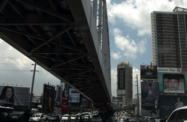Several major highway and light-rail transit (LRT) projects set to be rolled out next year could finally ease serious congestion problems in the Philippines.
The wave of planned projects comes on the back of a pledge made by President Benigno Aquino’s administration to substantially increase transport infrastructure spending as part of a broader bid to boost economic development and create a more attractive environment for foreign investors.
Having allocated billions of pesos for large, land-link construction projects, the government is keen to bring foreign contractors and investors on board by embarking on a number of public-private partnerships (PPPs).
A fresh drive is also under way to award the LRT-1 extension contract within the coming months, after progress stalled during the summer. However, with some experts questioning the efficiency of the country’s PPP framework, and key ventures already marked by delays, officials will be aware of the need to focus on enhancing cooperation with the private sector.
Land links upgrades
Construction on the third stage of the PHP26.5bn ($614m) Metro Manila Skyway (MMS), one of the key projects, is set to begin in the first half of 2014, the government announced in October.
The skyway will connect the southern and northern Luzon expressways, two major traffic arteries which link the capital city to regional urban centres. Its construction is expected to ease traffic congestion, reducing the two-hour journey from Makati to Quezon to just 15 minutes. Funding for the project is being provided by the Citra Central Expressway Corporation, while its roll-out will be overseen by the Department of Transportation and Communications (DoTC) and the Toll Regulatory Board (TRB).
Figures show that chronic congestion is weighing on the Philippines’ economic development. According to a 2013 report published by the Japan International Cooperation Agency (JICA), the country loses an estimated PHP2.4bn ($55.7m) daily due to traffic problems.
The Philippines also trails its neighbours when it comes to spending on public infrastructure, having channelled 2.5% of GDP into projects during 2012, half the 5% average allocated by other South-east Asian nations. The World Economic Forum’s (WEF) 2013 Global Competitiveness Report identified inadequate infrastructure as the main obstacle to doing business in the Philippines.
Manila’s LRT-1 line, which serves 172m passengers annually, has been in need of an upgrade for years. Just this month, the service was suspended briefly after a fire destroyed part of a power cable.
The Aquino administration announced in August that it planned to channel PHP399bn ($9.25bn) into public infrastructure projects in 2014, marking an increase of 35% on this year’s allocation. Funding for infrastructure is slated to increase to 25% of the budget, or 5% of GDP by 2016, according to Finance Secretary Cesar Purisima.
The Aquino administration is now targeting greater private sector involvement, building on the PPP scheme it set up in 2010 to help it meet its transportation development objectives. Aside from the MMS project, planned PPPs include a 7.5-km expressway connecting the Ninoy Aquino International Airport (NAIA) to southern metro Manila, which is expected to be completed by 2015, and a PHP35bn ($812m) Cavite-Laguna Expressway (Calax). In total, the Aquino administration has earmarked at least $4bn to fund PPP infrastructure projects.
Stumbling blocks
Despite holding plenty of promise for investment growth, the PPP programme has come in for criticism. In September 2013, Henry Schumacher, vice president of the European Chamber of Commerce of the Philippines (ECCP), called for a review of the scheme following several problematic auctions.
“It is time to review the failures and design a new concept,” Schumaker told local publication BusinessWorld. “ECCP feels that the PPP model designed by the DoTC obviously does not work.”
Schumaker’s comments come after a number of projects, including a contract for the PHP60bn ($1.39bn) LRT-1 extension project, the Philippines’ largest proposed PPP to date, were hit by delays in the tender process. The planned LRT-1 expansion suffered a major setback in August when three of the four bidders withdrew from the process and one offer submitted proved to be non-compliant.
Overly restrictive contracts, described by analysts as being unfavourable to foreign investors, are thought to be a key cause of delays. In the LRT-1 expansion, the value of real property taxes over the 35-year concessionary period using a build-operate-transfer (BOT) arrangement were estimated to cost more than the value of the project.
In response, the government announced plans in September to fast-track new PPPs through more attractive contracts. Cosette Canilao, executive director of the PPP Centre of the Philippines, a government organisation formed in 2009, told local media that the terms of the LRT-1 contract had been adjusted to provide a PHP2bn ($46.4m) subsidy to the winning bidder. The DoTC is also considering dropping real property taxes and raising LRT fares across the board. Transport officials hope to have a new bidding process for the LRT project finalised by early 2014.
Further reforms aimed at making the PPP schemes more commercially viable will sit well with international investors, while also helping the country to bridge its transportation gaps more smoothly, paving the way for economic growth.

